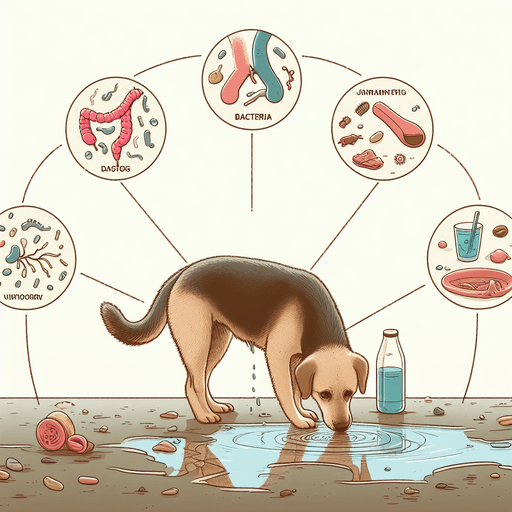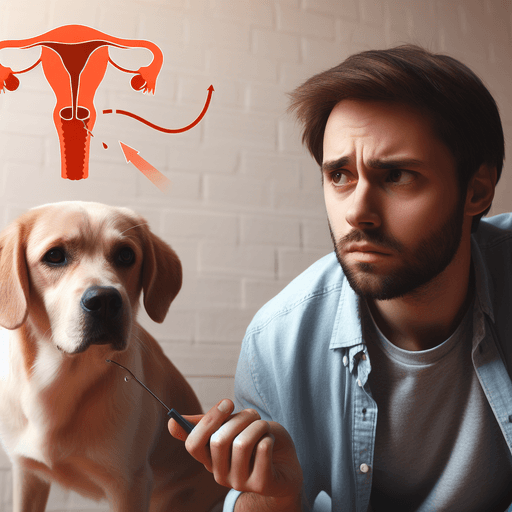Urinary Tract Infections (UTIs) in dogs aren’t rare. They occur when harmful bacteria find their way into the urinary tract via the urethra, causing infections in the bladder and kidneys. Certain conditions may make your canine companion more vulnerable to UTIs. These include a weak immune system, insufficient hydration, bladder stones, and inadequate hygiene.
If your dog is having trouble urinating, urinating more often than usual, has blood or cloudiness in their urine, is excessively licking their genitals, displaying signs of fever, lethargy, or a lack of appetite, they could be suffering from a UTI. Immediate veterinary attention is needed when these symptoms appear.
Once diagnosed, the treatment for a UTI in dogs usually includes a round of antibiotics. It’s vital to ensure the full course is completed to fully clear the infection and reduce the risk of a future UTI. Beyond medication, prevention strategies include ensuring your dog stays well hydrated and maintains good hygiene.
It’s also important to note that persistent UTI symptoms could potentially signal a more serious health issue, like bladder cancer in dogs. So, never ignore recurring symptoms and always consult your vet.
‘Prevention is better than cure. Keep your dogs hydrated and maintain good hygiene practices to keep UTIs at bay.
What are urinary tract infections (UTI) in dogs

Urinary tract infections (UTIs) in dogs are a fairly common health concern. These infections occur when harmful bacteria, often E. coli, infiltrate the urinary system of your pet. This typically happens when germs from urine, waste, or other debris make their way into the urinary tract. Dogs with compromised immune systems or with certain health conditions are more susceptible to UTIs.
The presence of a UTI can severely affect a dog’s quality of life. Signs of this type of infection include increased frequency of urination, visible struggle or discomfort while urinating, urine that appears bloody or cloudy, and a decreased appetite. If not properly addressed, UTIs can escalate into more serious health problems such as kidney infection or even kidney failure.
Detecting UTIs in dogs usually involves a urinalysis conducted by a vet. This process involves analyzing the chemical composition of the dog’s urine to look for any signs of bacteria, crystals, or cells indicative of an infection. In some cases, a urine culture may also be conducted to not only confirm the presence of a UTI but also to determine the most effective antibiotic treatment for the infection.
To treat UTIs in dogs, vets often prescribe a course of antibiotics to eliminate the infection. The full course of antibiotics must be completed to prevent a relapse. Additionally, encouraging your dog to drink more water can assist in flushing out bacteria during urination.
There isn’t any proven natural remedy for treating UTIs in dogs. However, you can take certain preventative measures to mitigate the risk of UTI. These include providing your pet with fresh, clean water daily, keeping the area around their urinary opening clean through regular grooming, and allowing them frequent opportunities to urinate.
As always, it’s best to consult with a vet for advice tailored specifically to your dog’s health needs.
How common are UTIs in dogs?


Urinary tract infections (UTIs) in dogs are a frequent health issue, influencing roughly 14% of dogs during their lifespan. These infections aren’t breed or age-specific; they can affect any dog, but older ones seem to be more susceptible. Female dogs tend to be more at risk due to their anatomical structure – their shorter urethra makes it easier for bacteria to ascend.
It’s not uncommon for male dogs to get UTIs, though it’s a rarer occurrence.
For dog owners, understanding the warning signs of UTIs is a must. These can include frequent urination, apparent pain or discomfort while urinating, the presence of blood in the urine, and abnormal licking of the genital area. Ignoring these signs could escalate UTIs to more serious conditions like kidney infections.
Routine vet visits and maintaining good hygiene are key to keeping UTIs at bay. It’s simple – provide your dog with clean drinking water and regular opportunities to relieve themselves to lessen the chance of infection.
What are the causes of UTIs in dogs?


Urinary tract infections (UTIs) in dogs can be attributed to a multitude of factors. The most prevalent cause is bacteria entering through the dog’s urethral opening. Dogs exposed to unclean surroundings, for instance, swimming in contaminated water or coming into contact with waste or debris, are more likely to contract UTIs. This exposure can lead to harmful bacteria, like E. coli, entering the urinary tract.
The health of the dog also plays a significant part in their susceptibility to UTIs. Dogs with compromised immune systems or pre-existing health conditions – including endocrine diseases, bladder obstructions or tumors, kidney disease, and prostate disease – have a heightened risk of getting a UTI.
Another potential cause is hormonal imbalances, which can alter pH levels in the urinary tract and create a more conducive environment for bacterial proliferation. Lastly, genetics can’t be ruled out. Certain dogs may be naturally more predisposed to UTIs than others.
Knowledge of these causes can aid in the prevention of UTIs in dogs, contributing to their overall health and well-being.
What are the symptoms of UTIs in dogs?


If your pet dog is dealing with a urinary tract infection (UTI), certain signs might give it away. Let’s discuss some of the main indicators:
- Drinking water more than normal: A sudden increase in your dog’s water intake might mean they’re dealing with a UTI. This heightened thirst is a frequent sign of UTIs in dogs.
- Losing bladder control: Dogs with UTIs could start having accidents indoors or struggle to control their bladder for the usual duration. This could be a significant issue, especially if your dog is generally well-behaved.
- Change in urine quality: A UTI might cause your dog’s urine to become bloody or cloudy. If you spot such changes, it’s advised to get your dog examined by a vet right away.
- Decreased appetite and excessive licking: Dogs with UTIs may not eat as much as usual and start to lick their genital area more frequently. These behaviors often point to the discomfort or pain caused by the infection.
Observing any of these signs should prompt you to get your dog to a veterinarian. To diagnose a UTI in dogs, vets conduct a detailed examination, including urinalysis, to test for bacterial presence. The most common treatment involves a prescribed course of antibiotics which must be finished in entirety to eliminate the infection. Probiotic supplements may also help by promoting healthy bacteria in the urinary tract and helping to prevent future UTIs.
Providing clean water, regular grooming, and frequent bathroom breaks can lower the risk of UTIs in dogs.
When to see a veterinarian for a UTI


When your dog starts showing signs of a urinary tract infection (UTI) like frequent urination, blood in urine or difficulty while urinating, don’t delay in getting a vet appointment. Mild UTIs might get better on their own, but professional vet care is recommended for an accurate diagnosis and treatment. The vet will conduct a urinalysis to confirm the UTI and will suggest the next steps.
While home remedies for UTIs in dogs can be tempting, they shouldn’t be the first line of treatment. Natural remedies might help ease the symptoms but shouldn’t replace a vet’s advice. Vets typically prescribe antibiotics to treat the infection. To avoid a recurrence, it’s vital to stick to the treatment plan and finish the entire course of antibiotics.
Ignoring UTIs in dogs can lead to grave situations like kidney infections or failure. If not treated timely, the infection might spread and cause lasting damage to the urinary tract. Therefore, it’s best to get vet care as soon as you detect any UTI symptoms in your dog to avoid any serious health issues.
Symptoms of UTIs in Dogs
Recognizing UTI Symptoms in Dogs
Is your pooch peeing more often than usual? Are they struggling while trying to urinate or only able to pass small amounts at a time? Have you noticed their urine appearing bloody or murky? These could be signs that your dog is suffering from a urinary tract infection (UTI).
These symptoms suggest the presence of harmful bacteria in your dog’s urinary tract, leading to an infection. Understanding these signs is the first step in getting the necessary help from a vet to accurately diagnose and treat your dog.
Frequent urination
If you notice that your dog is urinating more frequently than usual, it could be an indication of a urinary tract infection (UTI). Here’s a detailed understanding of what you need to know about frequent urination in dogs:
Potential Causes: A variety of factors can contribute to dogs urinating frequently. These include urinary tract infections (UTIs), bladder infections, the presence of bladder stones, prostate problems, and even imbalances in hormone levels.
Diagnostic Procedures: To pinpoint the exact cause of frequent urination, veterinarians might suggest a series of diagnostic tests. These can include a urine analysis, blood tests, X-rays, ultrasounds, urine cultures, cystoscopy, or even CT scans.
Options for Treatment: The treatment procedure for frequent urination will be based on its root cause. This could involve taking prescribed medications, undergoing hormone replacement therapy, surgical procedures, or other methods of managing the condition.
Methods of Prevention: Some measures can be taken to prevent frequent urination in dogs. These include providing your dog with fresh, clean water every day, allowing regular bathroom breaks, maintaining cleanliness around the urinary opening, and ensuring your dog’s overall health and immune system are in good shape.
Always keep in mind, if your dog is urinating more frequently, a consultation with your veterinarian for an accurate diagnosis and treatment is necessary. As the saying goes, ‘A healthy dog is a happy dog.’
Straining to urinate
If your pet dog is having a hard time urinating, it might be a sign that they have a urinary tract infection (UTI). This is a fairly common issue among dogs, and it’s something that should never be taken lightly. Observing your canine’s behavior can give you insights into their health condition. If they’re having difficulty while urinating or if you see blood in their urine or increased frequency of urination, it’s time to alert your vet.
The vet might perform a variety of diagnostic tests such as urinalysis, imaging, and potentially biopsies. The prescribed treatment will depend on the root cause of the UTI and may range from antibiotics to surgery or other interventions. It’s vital to remember that any difficulty in urination is a medical emergency and needs immediate attention.
- Product Highlights:
- Immediate diagnosis and treatment can help ease the discomfort and avoid further complications.
- Knowing the signs of UTI in dogs can help you recognize when your canine is suffering from this infection.
- Timely and appropriate treatment can help prevent the recurrence of UTIs in dogs.
However, there are certain downsides to consider:
- Overlooking the signs of a UTI can lead to severe complications.
- The cost of the treatment can be high, depending on the required tests and interventions.
- Some dogs might need continuous monitoring and management to prevent future UTIs.
Urinating small amounts
If you notice your dog is peeing in small amounts, it could be a sign of a urinary tract infection (UTI). This condition can make your dog feel an urgent need to pee, causing them to go more often but in reduced quantities. This situation isn’t comfortable for your dog and could be a red flag for issues with their urinary health.
Always ensure your dog has access to fresh and clean water daily; this helps rinse out bacteria from the urinary tract. It’s also beneficial to allow your dog frequent pee breaks.
If your dog gets a UTI diagnosis, there are several treatments available like antibiotics to eliminate the infection, fluid therapy to wash out bacteria, and medicine to ease discomfort. It’s also key to tackle any underlying conditions that could lead to UTIs, such as bladder stones or prostate problems, to avoid future occurrences.
Bloody urine
If you’ve noticed that your dog’s urine has blood in it, it’s a common sign of a urinary tract infection (UTI). But it’s not the only possible cause. Hematuria, the scientific term for blood in urine, can be caused by a variety of factors in dogs like UTIs, physical harm, poisonous substances, and even diseases like cancer. To find out what’s causing it, a trip to the vet is required.
The vet might perform different diagnostic tests such as colorimetric tests with a dipstick, an evaluation of the urine, an ultrasound, x-rays, or measure the blood pressure. These tests help pinpoint the exact reason behind the hematuria. The causes can vary from disorders related to blood clotting, diseases of the kidney, infections, growths, and cancer.
The treatment options for hematuria in dogs are dependent on the root cause and can be customized according to the dog’s individual needs and overall health condition. So it’s necessary to have a conversation with your vet to get the correct diagnosis and advice.
Possible Causes of Hematuria in Dogs and the Diagnostic Tests
| Possible Causes | Diagnostic Tests |
|---|---|
| UTIs | Evaluation of the urine |
| Physical harm | Colorimetric tests with a dipstick |
| Poisonous substances | Ultrasound |
| Cancer | X-rays |
| Disorders related to blood clotting | Measurement of blood pressure |
As the saying goes, “An ounce of prevention is worth a pound of cure.” So keep an eye on your dog’s health and seek veterinary advice when needed.
Cloudy urine
Cloudy Urine in Dogs: An Early Sign of Urinary Tract Infection (UTI)
Cloudy urine in your pet dog may be an early sign of a urinary tract infection (UTI) – a health issue that shouldn’t be overlooked. Not only can a UTI be uncomfortable for your pet, but if untreated, it could escalate into a more serious condition like a kidney infection.
Understanding Cloudy Urine
Cloudy urine in dogs can be caused by various factors, including bacterial infections, unwanted debris or crystals in the urinary tract, and underlying health conditions like bladder or kidney disease, diabetes, or prostate disease. Bacteria in the urinary tract or fecal material can cause the urine to become cloudy, while certain diseases can lead to similar symptoms.
Treating Cloudy Urine
If your pet dog is diagnosed with a UTI, your vet might suggest antibiotics to remedy the infection. Increasing your pet’s water intake is another effective way to flush out the harmful bacteria, which can be beneficial in managing this condition.
Preventing Cloudy Urine
Providing your pet with clean drinking water, ensuring regular bathroom breaks, giving probiotic supplements to boost healthy bacteria in the urinary tract, and maintaining cleanliness around your dog’s urinary opening can help prevent UTIs and subsequent cloudy urine.
The Importance of Addressing Cloudy Urine
Cloudy urine is more than just a minor inconvenience – it can be a warning sign of a UTI. Ignoring this symptom can lead to more severe health conditions, including kidney infection. Swift diagnosis and treatment can help prevent your pet from unnecessary discomfort and possible health complications. As a responsible pet owner, noticing and addressing cloudy urine in your dog is a proactive step towards maintaining their urinary health and overall well-being.
Strong-smelling urine
Strong-smelling urine in your pet dog can be a sign of a urinary tract infection (UTI). The odor, which can be quite off-putting, usually points to bacteria or other issues that need addressing. So, what can you do about it?
Making sure your dog has access to clean, fresh water every day is a good starting point. This water intake helps wash away bacteria from the urinary tract.
Fever
Continuing the discussion about urinary tract infections (UTIs) in dogs, it’s necessary to know about fever as a possible symptom. A dog might have a fever if its temperature is 103 degrees or above. Here’s some essential information on the matter:
As pet owners, it’s our responsibility to monitor our dogs’ health. So, if your dog has a fever, get in touch with your vet right away for a proper diagnosis and treatment.
Lethargy
Lethargy in Your Dog: What it Could Mean
When your dog seems listless, it could be a sign of a urinary tract infection (UTI) or other health issues. Lethargy can result from several health problems, including infections, obesity, pain, heart disease, anemia, kidney disease, liver disease, hormone irregularities, or certain medications. The key to addressing lethargy lies in tackling the root cause.
Preventing lethargy is all about keeping your dog healthy, with regular exercise, a balanced diet, and consistent vet check-ups. If your dog appears listless, it’s vital to get them to a vet as soon as possible to safeguard their health and address any potential health problems.
Loss of appetite
Reduced Hunger
A prevalent symptom of urinary tract infections (UTIs) in dogs is reduced hunger. Should your pet display this symptom, it may indicate a UTI. Here’s what you need to know about reduced hunger in dogs suffering from UTIs:
Abdominal pain
When it comes to the health of your pet, noticing the signs of abdominal discomfort is key in diagnosing a urinary tract infection (UTI). It’s common for dogs with UTIs to experience this discomfort, so it’s not a symptom to overlook. Factors causing abdominal pain in dogs range from bladder inflammation, infection, disease, to even kidney disease.
When your dog shows signs of abdominal pain, the next step should be an immediate visit to the vet.
To prevent your dog from suffering abdominal pain, ensure they stay hydrated, keep the area around their urinary opening clean, and allow them enough opportunities to relieve themselves.
Taking note of severe abdominal condition symptoms is also critical, such as continuous vomiting, bloating, or unusual breathing. These symptoms require immediate attention from a veterinarian.
Signs of a Serious Abdominal Condition:
- Continuous vomiting
- Bloating
- Unusual breathing
It’s our responsibility as pet owners to notice these signs and take swift action to ensure our pets’ well-being.
Breed (some breeds are more predisposed to UTIs, such as beagles, cocker spaniels, and dalmatians)
Certain dog breeds, like beagles, cocker spaniels, and Dalmatians, are more prone to urinary tract infections (UTIs). Despite the fact that UTIs can affect dogs of all ages and breeds, these specific ones seem to have a higher susceptibility. Owners of these breeds need to be conscious of this heightened risk and take steps to safeguard their pets’ health.
Prompt medical attention is crucial if a dog from these prone breeds develops a UTI.
Being vigilant and taking preventive steps can greatly help to maintain your pet’s health and keep them UTI-free.
Pyelonephritis (infection of the kidneys)
Urinary tract infections (UTIs) in dogs may seem like a minor issue, but without proper care and treatment, they can escalate into a serious health concern known as pyelonephritis. This is an infection that affects the kidneys when bacteria from the lower urinary tract ascend, causing inflammation and infection. Immediate diagnosis and treatment can help avoid complications and long-term health consequences.
To identify pyelonephritis, your vet might conduct a urine culture to pinpoint the exact bacteria causing the infection. This can then guide the choice of the most effective antibiotics for treatment. The typical course of action is administering antibiotics for several weeks, along with other supportive care to alleviate symptoms and aid recovery.
Pyelonephritis, when not treated in time, can cause kidney damage and even lead to kidney failure. Therefore, it’s essential to keep an eye out for any signs of UTIs and get veterinary intervention as soon as possible if symptoms appear.
Frequently Asked Questions
Can UTIs in Dogs Be Transmitted to Humans?
Urinary tract infections (UTIs) in dogs have the potential to be passed on to their human companions, making it a zoonotic concern. To minimize the chance of this happening, it’s recommended that you follow certain precautions such as maintaining good cleanliness habits, washing your hands regularly, and avoiding direct contact with urine from an infected dog.
When a dog is diagnosed with a UTI, vets often prescribe antibiotics which have been proven to effectively treat the condition. Probiotics, as a preventive measure, can also be beneficial for a dog’s urinary health.
For the best advice on diagnosing, treating, and preventing UTIs in dogs, and reducing the chances of transmission to humans, it’s always advisable to seek advice from a vet.
Are There Any Natural Remedies or Home Treatments for UTIs in Dogs?
Considering natural or home-based remedies for urinary tract infections (UTIs) in dogs, a range of solutions might come to mind. Some dog owners lean towards herbs, dietary supplements, or even cranberry juice as potential solutions to soothe UTI symptoms in dogs.
Despite these notions, it’s worth mentioning that the effectiveness of these remedies hasn’t been confirmed by scientific research. Therefore, if your canine companion is dealing with a UTI, it’s strongly advised to seek advice from your veterinarian. They’re the most qualified to offer advice and suggest the most fitting treatment for your pet’s condition.
Can Stress or Anxiety in Dogs Contribute to the Development of Utis?
About dogs, stress, and anxiety can indeed lead to urinary tract infections (UTIs). When dogs are under stress, they might display behaviors like excessive licking or marking territory with urine. These actions can introduce bacteria into the urinary tract, potentially leading to an infection.
Moreover, anxiety can weaken a dog’s immune system, leaving them more vulnerable to infections. Hence, managing your pet’s stress levels is a preventive measure against UTIs. Methods can include regular exercise, mental challenges, and creating a serene, safe environment for them.
As the famous vet, Dr. James Herriot once said, ‘Animals are sentient, intelligent, perceptive, funny and entertaining. We owe them a duty of care as we do to children.’ It’s our responsibility as pet owners to ensure our pets are happy and healthy, which in turn can help prevent health issues such as UTIs.
Can a Dog’s Diet Affect Their Susceptibility to Utis?
Can a Dog’s Diet Influence Their Vulnerability to UTIs?
Indeed, what you feed your dog can impact their vulnerability to UTIs. A balanced diet rich in vital nutrients can fortify their immune system, thereby lowering infection chances.
Incorporating probiotics into their diet can prove helpful too. Probiotics foster the growth of beneficial bacteria in the urinary tract.
Cranberry supplements are another good addition to your dog’s diet. They’ve earned a reputation for being potentially protective against UTIs.
Water intake is another important aspect to consider. Keeping your dog well-hydrated aids in the elimination of bacteria through urination.
As the adage goes, ‘You are what you eat,’ this holds for our dogs as well. A well-balanced diet can be a simple yet effective way of keeping UTIs at bay.
Are There Any Specific Hygiene Practices That Can Help Prevent UTIs in Dogs?
To protect your dog from urinary tract infections (UTIs), hygiene plays a significant role. Consistent grooming, particularly around the area of the urinary opening, is a practical way to block the entry of bacteria.
It’s also helpful to ensure that your pet always has access to fresh, uncontaminated water. This aids in expelling bacteria from the urinary tract.
Encouraging your pet to urinate frequently is another efficient method to keep UTIs at bay.
Conclusion
Understanding the signs of urinary tract infections in dogs is key to securing their well-being. As a responsible pet owner, you hold the power to safeguard your pet’s health. Ensure they drink plenty of water and maintain a clean environment to protect them from these bothersome infections.
A well-maintained urinary tract results in a cheerful and comfortable canine companion. So, use your knowledge as their protection and keep their tail wagging with delight. As the saying goes, ‘The best defense is a good offense.’
